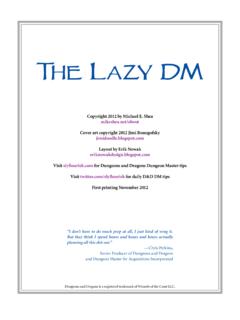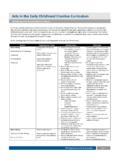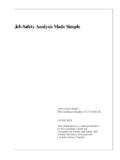Transcription of North Carolina Essential Standards Beginning Music
1 North Carolina Essential Standards Beginning Music Note on Numbering: B- Beginning High School Standards Note on Strands: ML Musical Literacy, MR Musical Response, CR Contextual Relevancy Note: Students at the high school level will have the option of studying an individual arts discipline as an area of interest, or specializing or completing a concentration in studies to prepare them for further education and/or a career in the arts. The Essential Standards communicate what students should know and be able to do as a result of instruction at each proficiency level: Beginning , intermediate, proficient, and advanced (9-12).
2 Beginning High School Music Standards are designed for students with no or limited K-8 progression in Music education. Musical Literacy Essential Standard Clarifying Objectives steady tone while performing Music . the fundamental techniques of singing or playing an instrument properly with a diverse and varied repertoire of Music . Apply the elements of Music and musical techniques in order to sing and play Music with accuracy and expression. expressive elements (such as dynamics, timbre, blending, and phrasing) when singing or playing a varied repertoire of Music .
3 Whole, half, quarter, eighth, sixteenth, and dotted note and rest duration in 2/4, 3/4, and 4/4 meters. standard notation symbols for pitch. Interpret the sound and symbol systems of Music . standard notation symbols for basic elements of Music , such as pitch, rhythm, dynamics, tempo, articulation, and expression. short, rhythmic improvisations using a variety of traditional and non-traditional sound sources. Create Music using a variety of sound and notational sources. simple rhythmic and/or melodic compositions using a variety of traditional and non-traditional sound, notational, and technological sources.
4 North Carolina Essential Standards High School Music Musical Response Essential Standard Clarifying Objectives Illustrate perceptual skills by moving to, answering questions about, and describing aural examples of Music of various styles and cultures. Analyze aural examples of Music representing diverse genres, styles, and cultures in terms of the basic elements of Music and their interrelationships. Understand the interacting elements to respond to Music and Music performances. Identify criteria for evaluating performances, compositions, and musical ideas and apply the criteria in personal listening and performing.
5 Contextual Relevancy Essential Standard Clarifying Objectives Use Music to explore concepts in world history and relate them to significant events, ideas, and movements from a global context. Understand the relationships between Music and concepts from other areas. Understand laws regarding the proper access, use, and protection of Music . Identify basic health and wellness issues that performing artists often experience. Understand global, interdisciplinary, and 21st century connections with Music . Compare the various roles that musicians can and do perform and the conditions under which Music is performed.
6 North Carolina Essential Standards High School Music North Carolina Essential Standards Intermediate Music Note on Numbering: I - Intermediate High School Standards Note on Strands: ML Musical Literacy, MR Musical Response, CR Contextual Relevancy Note: Students at the high school level will have the option of studying an individual arts discipline as an area of interest, or specializing or completing a concentration in studies to prepare them for further education and/or a career in the arts. The Essential Standards communicate what students should know and be able to do as a result of instruction at each proficiency level: Beginning , intermediate, proficient, and advanced (9-12).
7 Intermediate High School Music Standards are designed for those students who have had a complete K-8 progression in Music education or who have achieved Beginning level high school Standards for Music . Musical Literacy Essential Standard Clarifying Objectives Use characteristic tone and consistent pitch to sing and/or play Music . Use the fundamental techniques (such as posture, playing position, breath control, fingerings, and bow hold) to sing or play an instrument properly. Apply the elements of Music and musical techniques in order to sing and play Music with accuracy and expression.
8 Interpret expressive elements, including dynamics, timbre, blending, accents, attacks, releases, phrasing, and interpretation, while singing or playing a diverse repertoire of Music with technical accuracy. Interpret whole, half, quarter, eighth, sixteenth, and dotted note and rest durations in simple duple, simple triple, and simple compound meters. Interpret standard notation symbols for pitch in appropriate clefs. Interpret the sound and symbol systems of Music . Use standard symbols for pitch and rhythm to notate personal musical ideas and the musical ideas of others.
9 Use improvisation to create simple melodies over given chord progressions. Create Music using a variety of sound and notational sources. Construct Music examples using a variety of traditional and non-traditional sound, notational, and technological sources. North Carolina Essential Standards High School Music Musical Response Essential Standard Clarifying Objectives Interpret the gestures of a conductor when singing or playing an instrument. Classify examples of Music by genre or style and by historical period or culture, explaining the justification for the classifications using correct musical terminology.
10 Understand the interacting elements to respond to Music and Music performances. Generate specific criteria for evaluating the quality and effectiveness of Music and apply criteria in personal participation in Music . Contextual Relevancy Essential Standard Clarifying Objectives Use Music to explore concepts of civics and economics (such as systems, functions, structures, democracy, economies, and interdependence). Understand the relationships between Music and concepts from other areas. Understand the importance of ethical responsibility in protecting creative works and intellectual property.















